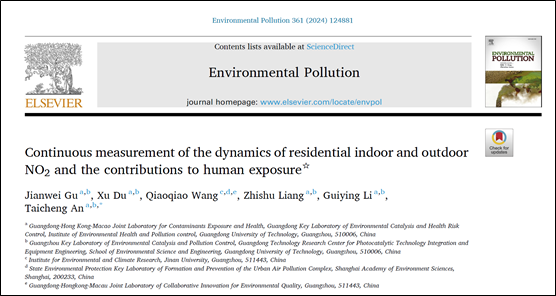近日,广东工业大学环境健康与污染控制研究院、环境科学与工程学院安太成教授团队在居民室内外NO2的动态变化特征和人体暴露贡献方面取得新研究进展,研究成果以“Continuous measurement of the dynamics of residential indoor and outdoor NO2 and the contributions to human exposure”为题,发表在Environmental Pollution (2024, 361:124881;https://doi.org/10.1016/j.envpol.2024.124881) 期刊上。论文的第一作者为我院顾建伟教授,通讯作者为安太成教授。
该研究在广州市居民家庭开展了室内外NO2的连续测量,获得了室内厨房、客厅、室外NO2的同步动态变化特征,揭示了室内-室外NO2的关系,并量化了室内源和室外源对人体暴露的贡献。主要发现燃气炉具的使用是居民家庭室内主要的NO2源,尽管总体上只贡献了室内NO2的15-27%,但其可导致短时间的高NO2暴露,对室内NO2的暴露评估和风险防控具有重要意义。

论文网址: https://doi.org/10.1016/j.envpol.2024.124881
中文摘要
在居住环境中,二氧化氮(NO2)是一种重要的空气污染物。然而,室内NO2的动态变化特征和室内-外源对人体暴露的贡献尚不清晰。本研究对中国广州的八户家庭在冬、夏两季分别进行了连续的NO2测量。使用NO2监测仪获得了室内(厨房、客厅)和室外(阳台)的同步高时间分辨率NO2数据集;确定了室内外NO2水平和时间变化模式,分析了室内外关系,并量化了室内NO2暴露的来源。结果发现室内NO2总体上高于室外,在大多数情况下厨房的NO2水平最高。厨房中NO2呈现燃气灶使用导致的多峰值特征,而同期的客厅NO2也有一定程度升高,但峰值通常较小。室内外NO2的相关性冬季要强于夏季,夜间强于白天。设计概念模型分离了室内NO2的来源,发现室外源贡献了厨房中73%-76%的NO2,客厅中76%-85%的NO2。室内与室外NO2源作用于室内的模式截然不同:室外NO2源的贡献始终存在于室内,而室内NO2源则偶尔出现,但贡献很高。这对室内NO2源导致的短期、高浓度的暴露评估具有非常重要意义,室内NO2的急性健康效应值得关注。
图文摘要

英文摘要
In residential environment, NO2 is an important air pollutant. Yet, the dynamics of indoor NO2 and source contributions to human exposure are not well understood. Here, we conducted a continuous NO2 measurement in and out of eight households in Guangzhou, China. Paired high time-resolution NO2 data sets indoors (kitchen, living room) and outdoors (balcony) were obtained with NO2 monitors. We summarized the indoor and outdoor NO2 levels, identified temporal variation patterns, analyzed indoor-outdoor relationships, and quantified source contributions to indoor NO2 exposure. Indoor NO2 were overall higher than outdoor NO2, and in most cases, the highest NO2 levels were observed in the kitchen. NO2 in the kitchen was characterized by multiple spikes associated with use of gas stoves, while NO2 in the living room was also elevated but the peaks were generally smaller. The indoor-outdoor correlations were stronger in winter than in summer, and were stronger in nighttime than daytime. The sources contributing to indoor NO2 were separated with a conceptual model. Overall, the outdoor NO2 source contributed 73%–76% of the NO2 in the kitchen, and 76%–85% in the living room. The source pattern was quite different: outdoor NO2 sources were present indoors all the time; by contrast, indoor NO2 sources were present sporadically but with a very high contribution. This has important implication to the exposure assessment that indoor NO2 sources lead to short-term high exposure, and deserves attention regarding acute health effects.
项目资助
本研究受到国家重点研发项目(2022YFC3702602,2023YFC3905102),广东省基础与应用基础研究基金项目(2022A1515011213),国家自然科学基金面上项目(42477430)和国家环境保护城市大气复合污染成因与防治重点实验室开放基金项目(SEPAir- 2022080592)的资助。